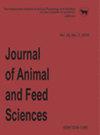数字畜牧系统对蛋鸡动物行为和福利以及鸡蛋脂肪酸含量的影响
IF 1.5
4区 农林科学
Q3 AGRICULTURE, DAIRY & ANIMAL SCIENCE
引用次数: 2
摘要
. 通过畜牧业生产和信息通信技术的融合,数字化畜牧业系统正在被应用于畜牧业农场,以改善动物行为和福利,提高动物食品的产量和质量。在之前的研究中,我们注意到使用数字化畜牧系统可以大大提高蛋鸡的产蛋量。本研究探讨了数字化饲养系统对蛋鸡脂肪酸谱和鸡蛋胆固醇、动物行为和福利的影响。试验选用300只48周龄的海兰褐蛋鸡,采用随机完全区组设计,分为传统饲养系统(CON)和数字饲养系统(DLS) 2个处理组,为期10周。DLS组蛋鸡的饮水、羽蹲、进食、移动、整理、休息等行为指标得分显著高于CON组(均P < 0.05)。DLS组蛋鸡的外观、羽毛状况、体况和健康状况等动物福利评分显著高于CON组(P < 0.05)。DLS组鸡蛋油酸和不饱和脂肪酸含量显著高于CON组(P < 0.05)。但DLS组鸡蛋饱和脂肪酸含量和n-6/n-3脂肪酸比值显著低于CON组(P < 0.05)。这些结果表明,数字畜牧系统可以作为未来的畜牧算法,显著改善蛋鸡的鸡蛋脂肪酸分布、动物行为和福利。本文章由计算机程序翻译,如有差异,请以英文原文为准。
Effect of digital livestock system on animal behavior and welfare,and fatty acid profiles of egg in laying hens
. Digital livestock system through convergence of livestock production and information and communication technology is being applied to livestock farms to improve animal behavior and welfare, production, and quality of animal food. In previously study, we noted that the egg production were greatly enhanced in laying hens using digital livestock system. The present study investigated effects of a digital livestock system on fatty acid profiles and cholesterol of eggs, animal behavior, and welfare of laying hens. A total of 300 laying hens (Hy-Line Brown) at 48 weeks old were divided into two treatment groups: conventional livestock system (CON) and digital livestock system (DLS) in a randomized complete block design for 10 weeks. Drinking, feather squatting, eating, moving, preening, and resting scores as behavior indicators of laying hens were significantly improved in the DLS group than in the CON group (all P < 0.05). Animal welfare scores such as appearance, feather condition, body condition, and health of laying hens were significantly higher in the DLS group than in the CON group ( P < 0.05). Contents of oleic acid and unsaturated fatty acid of eggs were significantly increased in the DLS group compared to the CON group ( P < 0.05). However, content of saturated fatty acid and n-6/n-3 fatty acid ratio of eggs of the DLS group were significantly lower than those in the CON group ( P < 0.05). These results indicate that the digital livestock system can be used as a future livestock farming algorithm to significantly improve egg fatty acid profile, animal behavior, and welfare in laying hens.
求助全文
通过发布文献求助,成功后即可免费获取论文全文。
去求助
来源期刊

Journal of Animal and Feed Sciences
农林科学-奶制品与动物科学
CiteScore
2.10
自引率
0.00%
发文量
42
审稿时长
3 months
期刊介绍:
Journal of Animal and Feed Sciences (JAFS, J. Anim. Feed Sci.) has been published by the Kielanowski Institute of Animal Physiology and Nutrition, Polish Academy of Sciences in Jabłonna (Poland) since 1991. It is a continuation of the Polish-language journal Roczniki Nauk Rolniczych. Seria B, Zootechniczna published by the Polish Academy of Sciences since 1969.
JAFS is an international scientific journal published quarterly, about 40 papers per year including original papers, short communications and occasionally reviews. All papers are peer-reviewed and related to basic and applied researches in the field of animal breeding and genetics, physiology of nutrition, animal feeding, feed technology and food preservation. The journal distinguishes the multidisciplinary nature of physiological and nutritional sciences and so includes papers specialized in all fields connected with animal well-being, including molecular and cell biology and the emerging area of genetics.
 求助内容:
求助内容: 应助结果提醒方式:
应助结果提醒方式:


